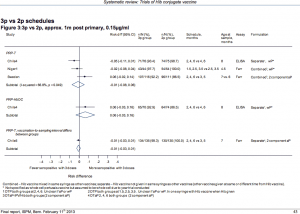Ideally there would be i) an agreed and comprehensive list of well-defined and standardized data essential to ensure rational and evidence based decisions on immunization schedules; and ii) a process for gathering and auditing these data, and making them available in suitable format for decision-makers. Currently we have neither of these. Decision makers often assess trade-offs and make decisions using incomplete data and whatever analysis is at their disposal. This project is seeking to develop item i), and make some tentative steps towards item ii).
Consultation with vaccine and policy experts has helped us to develop a preliminary and provisional list as follows:
- Primary responses to vaccination: by age, type of vaccine (monovalent or in combination with other antigens), number of doses, timing of doses, boosters doses;
- Duration of protection from immunization: by age at vaccination, number of doses, other factors (e.g. nutrition, HIV) and also duration of protection from infection and (if any) from passively acquired immunity;
- Vaccine safety issues – antigen-related adverse event/reaction (minor, serious, acute, long term) by age, number of doses, interval between doses; co-administration with other vaccines;
- Age-specific and country specific disease incidence (and prevalence) of infection for key end points (e.g. by disease symptoms, lab confirmation); age-specific case-fatality ratio; age-specific (and serotype specific if relevant) carriage rates;
- Robustness of available immunological correlates of protection (by infection or immunization), cut-off points for naturally acquired or vaccine-induced protection. How these are measured (assays and units of measurement);
- Logistic and operational factors – assessment of the optimal time points for the delivery of vaccine and operational factors (e.g. drop-out rates, missed opportunities for vaccination, overall health infrastructure) driving the delivery of different doses of vaccines; integration with other health interventions
- Impact and economic outcome variables – Costs of diseases and interventions; DALYS, QALYS, percentage reduction in disease specific and all cause morbidity and mortality, herd immunity threshold obtained, feasibility of various disease control goals;
- Epidemiological setting/region/country specific background characteristics: birth rates, age-specific all-cause mortality rates, age distribution of population, level of urbanization (overcrowding and mixing patterns), health systems infrastructure, vaccination coverage and current schedules, HIV prevalence (if will impact on immunity or uptake of vaccination);
This website is ‘work in progress’ and will continue to be so, but it is a step towards item ii) above: gathering and auditing relevant data, and making them available in suitable format for decision-makers. So far it provides:
- systematic reviews of 3 vaccine antigens (Haemophilus influenza type B, Rotavirus and Pneumococcal conjugate vaccines). The body of existing evidence on immunization schedules for these childhood vaccines was reviewed using standardized methods, to provide a thorough and up-to-date summary of the evidence. This should provide insights about the range of schedules that might be suitable for different epidemiological scenarios; and
- evidence synthesis through modelling and graphic presentation of the expected impact of different schedules under a range of scenarios that can vary in terms of epidemiology, vaccine coverage and timeliness, vaccine efficacy and duration of protection, and other factors; and relating these to what is known about the circumstances in each country.


